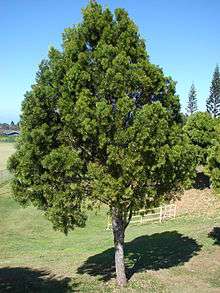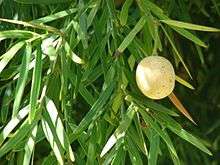Afrocarpus gracilior
| Afrocarpus gracilior | |
|---|---|
 | |
| Scientific classification | |
| Kingdom: | Plantae |
| Division: | Pinophyta |
| Class: | Pinopsida |
| Order: | Pinales |
| Family: | Podocarpaceae |
| Genus: | Afrocarpus |
| Species: | A. gracilior |
| Binomial name | |
| Afrocarpus gracilior (Pilg.) C.N.Page | |

Afrocarpus gracilior (syn. Podocarpus gracilior) is a species of coniferous tree in the family Podocarpaceae known commonly as the East African yellowwood.[1] It is native to eastern Africa, where it is widely distributed.[1]
It is a medium-sized tree, growing 20–40 m tall, rarely to 50 m, with a trunk diameter of 50–80 cm. The leaves are spirally arranged, lanceolate, 2–6 cm long and 3–5 mm broad on mature trees, larger, to 10 cm (4 in) long and 6 mm broad on vigorous young trees. The seed cones are highly modified, with a single 2 cm (1 in) diameter seed with a thin fleshy coating borne on a short peduncle. The mature seed is purple, and is dispersed by birds and monkeys which eat the fleshy coating. The pollen cones are solitary or in clusters of two or three on a short stem.[2]
This is a common species found in many types of tropical mountain forest habitat. It is a dominant species in some areas. Nevertheless, it may be in slow decline due to deforestation and logging.[1]
It is an important timber tree in its native range, where it is harvested for local use and export. It is used for construction of buildings and furniture. It is grown in plantations elsewhere in the world. It is considered to be a good shade tree.[1]
Notes
| Wikimedia Commons has media related to Afrocarpus gracilior. |
- 1 2 3 4 Farjon, A. 2013. Afrocarpus gracilior. The IUCN Red List of Threatened Species. Version 2014.3. Downloaded on 11 April 2015.
- ↑ Afrocarpus gracilior. The Gymnosperm Database.
References
- Dallimore, W., & Jackson, A. B. (1966). A Handbook of Coniferae and Ginkgoaceae, 4th ed., revised. Edward Arnold.
